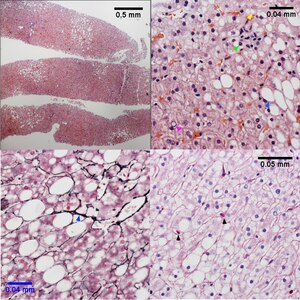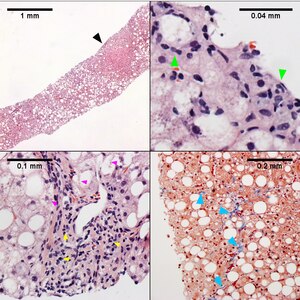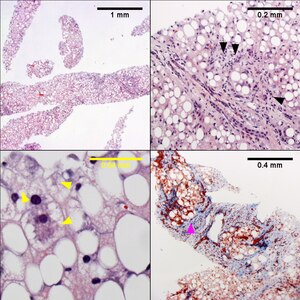Difference between revisions of "Steatohepatitis"
(→Images: added case with big pictures) |
(→Images: Replaced a non-large image case with a large image case) |
||
| Line 180: | Line 180: | ||
|} | |} | ||
Steatohepatitis Brunt necroinflammatory grade 3, Brunt fibrosis stage 1 (not shown). Panacinar steatosis with unremarkable, small triads (UL 40X). Ballooning degeneration, with cytoplasmic tufts (arrows) (UR 400X). Lipogranuloma (LL 400X). Triad with mild chronic inflammation without interface hepatitis (LR 400X). | Steatohepatitis Brunt necroinflammatory grade 3, Brunt fibrosis stage 1 (not shown). Panacinar steatosis with unremarkable, small triads (UL 40X). Ballooning degeneration, with cytoplasmic tufts (arrows) (UR 400X). Lipogranuloma (LL 400X). Triad with mild chronic inflammation without interface hepatitis (LR 400X). | ||
{| | |||
[[File:1 Steatohep 5 680x512px.tif|Steatosis afflicts almost all hepatocytes (pan-acinar) (Row 1 Left 40X).]] | |||
[[File:2 Steatohep 5 680x512px.tif|An isolated septal duct with concentric fibrosis (arrow) should not result in a diagnosis of primary sclerosing cholangitis. The patient had a normal bilirubin. (Row 1 Right 200X).]] | |||
<br> | |||
[[File:3 Steatohep 5 680x512px.tif|Cytoplasmic tufts (arrows) prove ballooning degeneration (Row 2 Left 400X).]] | |||
[[File:4 Steatohep 5 680x512px.tif|PAS with diastase shows PAS-D Kupffer cells (arrows) (Row 2 Right 400X).]] | |||
<br> | |||
[[File:5 Steatohep 5 680x512px.tif|Reticulin shows thick black lines (red arrows) of collapse, without portal central bridging. The apparent loss of reticulin due to steatosis (double head cyan arrow) should not be considered regeneration or hepatoma (Row 3 Left 200X).]] | |||
[[File:6 Steatohep 5 680x512px.tif|Trichrome shows a bridge (arrows) (Row 3 Right 200X).]] | |||
|} | |||
Steatohepatitis. Brunt necroinflammatory grade 3, Brunt fibrosis stage 3. Steatosis afflicts almost all hepatocytes (pan-acinar) (Row 1 Left 40X). An isolated septal duct with concentric fibrosis (arrow) should not result in a diagnosis of primary sclerosing cholangitis. The patient had a normal bilirubin. (Row 1 Right 200X). Cytoplasmic tufts (arrows) prove ballooning degeneration (Row 2 Left 400X). PAS with diastase shows PAS-D Kupffer cells (arrows) (Row 2 Right 400X). Reticulin shows thick black lines (red arrows) of collapse, without portal central bridging. The apparent loss of reticulin due to steatosis (double head cyan arrow) should not be considered regeneration or hepatoma (Row 3 Left 200X). Trichrome shows a bridge (arrows) (Row 3 Right 200X). | |||
{| class="wikitable sortable" | {| class="wikitable sortable" | ||
| Line 191: | Line 202: | ||
| [[Image:Steatohepatitis Cases 02.tif |thumb| Fibrosis stage 2 Brunt necroinflammatory grade 1 (WC)]] | | [[Image:Steatohepatitis Cases 02.tif |thumb| Fibrosis stage 2 Brunt necroinflammatory grade 1 (WC)]] | ||
| Necroinflammatory grades Brunt 1, NAH 3. Fibrosis stage 2. Overall, about a third of the biopsy shows mostly macrovesicular steatosis (UL). Rare inflammatory aggregates and ballooned hepatocytes were seen, but occasional linear/ropy Mallory hyalin was seen (UR blue arrowhead). Although trichrome can highlight Mallory hyalin (LL red arrowhead), the remainder of the image shows other cytoplasmic collections will also stain blue/blue-grey. The trichrome stain also showed peri-portal fibrosis (LR, yellow arrowheads). Original oculars UL 4X, UR 40X (higher pixel photograph), LL 40X (higher pixel photograph), LR 20X | | Necroinflammatory grades Brunt 1, NAH 3. Fibrosis stage 2. Overall, about a third of the biopsy shows mostly macrovesicular steatosis (UL). Rare inflammatory aggregates and ballooned hepatocytes were seen, but occasional linear/ropy Mallory hyalin was seen (UR blue arrowhead). Although trichrome can highlight Mallory hyalin (LL red arrowhead), the remainder of the image shows other cytoplasmic collections will also stain blue/blue-grey. The trichrome stain also showed peri-portal fibrosis (LR, yellow arrowheads). Original oculars UL 4X, UR 40X (higher pixel photograph), LL 40X (higher pixel photograph), LR 20X | ||
|- | |- | ||
|[[Image:Steatohepatitis Cases 05.tif |thumb| Fibrosis stage 4 Brunt necroinflammatory grade 3 (WC)]] | |[[Image:Steatohepatitis Cases 05.tif |thumb| Fibrosis stage 4 Brunt necroinflammatory grade 3 (WC)]] | ||
Revision as of 15:36, 19 August 2016
| Steatohepatitis | |
|---|---|
| Diagnosis in short | |
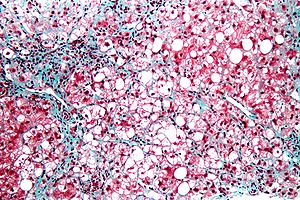 Steatohepatitis. Trichrome stain. | |
|
| |
| LM | steatosis (usually macrovesicular); hepatocyte injury -- ballooning degeneration (key feature), Mallory bodies; portal bridging (late stage) |
| Subtypes | by etiology (classically): ASH, NASH -- all almost histologically identical |
| LM DDx | steatosis, Wilson disease, hepatitis C, drug-induced liver disease |
| Gross | pale/yellowish, often enlarged |
| Site | liver - see medical liver disease |
|
| |
| Associated Dx | obesity, alcohol abuse |
| Prevalence | common |
| Prognosis | dependent on underlying cause |
| Treatment | dependent on underlying cause |
Steatohepatitis is a fatty change of the liver (steaosis) with (histologic) evidence of liver injury. It can be due to a number of different causes.
General
- Steatohepatitis is a label for a set of histopathologic findings.
- Fat accumulation (in hepatocytes) alone is liver steatosis.
- It may be a pattern seen in drug toxicity, e.g. methotrexate toxicity.[1]
Etiology:
- Alcohol = alcoholic steatohepatitis (ASH).
- Not alcohol = non-alcoholic steatohepatitis (NASH).
- Drug/toxin.[2]
Notes:
- Pathologists can comment on the etiology; however, the histomorphology is not distinctive. In other words, ASH and NASH are clinical diagnoses.
- Steatohepatitis is a misnomer. It is not an -itis; inflammation is not the (predominant) pathologic process.
Microscopic
Features:
- Steatosis (usually macrovesicular) - key feature.
- If less than 10% ... consider alt. diagnosis/disease process.
- Hepatocyte injury:
- Ballooning degeneration - key feature. †
- Mallory bodies.
- Mallory body wannabes: "occasional cytoplasmic clumping".
- +/-Chicken-wire perisinusoidal fibrosis +/- zone III (centrilobular) fibrosis (early).
- Late-stage disease - portal bridging.[3]
Note:
- † Brunt does not require ballooning to be present to call steatohepatitis;[4] however, a table in a later paper Brunt paper (surveying pathologists) suggest that a significant number of pathologist may consider it a required finding.[5]
DDx:
- Steatosis - lacks ballooning degeneration and neutrophils.
- Wilson disease.
- Hepatitis C.
- Drug-induced liver disease.
Image
Grading steatohepatitis
A simple grading system
| Grade | Characteristics |
|---|---|
| 1 | steatosis, occasional ballooning, scattered PMNs |
| 2 | steatosis, obvious ballooning, obvious PMNs, chronic inflammation |
| 3 | panacinar steatosis, obvious ballooning |
Brunt grading system
Brunt's 1999 paper proposed a system:[4]
| Grade | Steatosis | Neutrophils | Ballooning | Chronic inflammation |
|---|---|---|---|---|
| 1 | <=66% | scattered, rare | occasional or absent (zone 3) | none or mild acinar, none or mild portal |
| 2 | any amount (>33%) | present | obvious ballooning | mild or moderate acinar, mild or moderate portal |
| 3 | panacinar, zone 3 predominant | present | present, obvious | mild acinar inflammation, mild or moderate (not marked) portal |
Clinical Research Network system
Nonalcoholic steatohepatitis Clinical Research Network system for scoring activity - adapted from Brunt and Tiniakos:[6]
| Score | Steatotic hepatocytes (%) |
Foci of lobular lymphocytes |
Ballooning heptocytes |
|---|---|---|---|
| 0 | <5% | none | none |
| 1 | 5-33% | <2 | few |
| 2 | 34%-66% | 2-4 | many |
| 3 | >66% | >4 | (not assigned) |
Staging steatohepatitis
| Stage | Fibrosis | Notes |
|---|---|---|
| 0 | none | - |
| 1 | zone 3 perisinusoidal | may be focal or extensive |
| 2 | perisinusoidal and periportal | no bridging |
| 3 | bridging fibrosis | no nodule formation |
| 4 | nodule formation | - |
Images
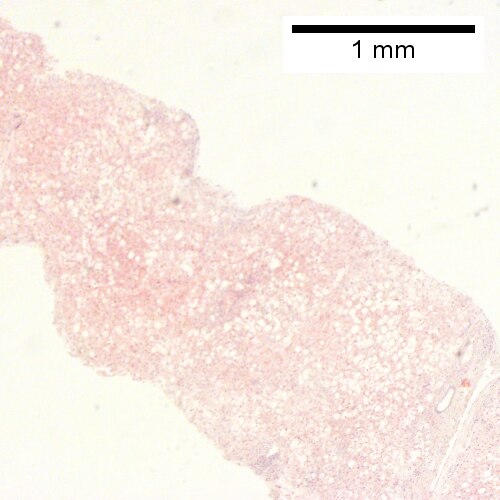
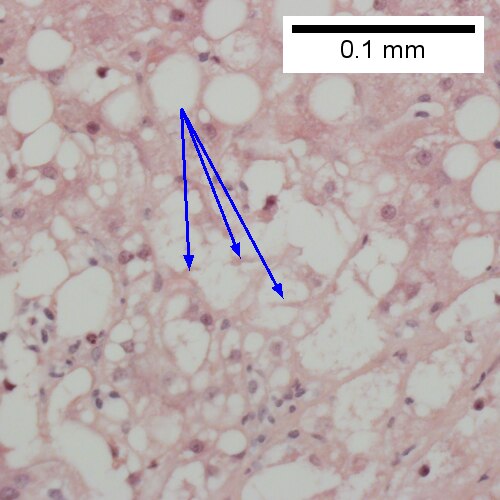
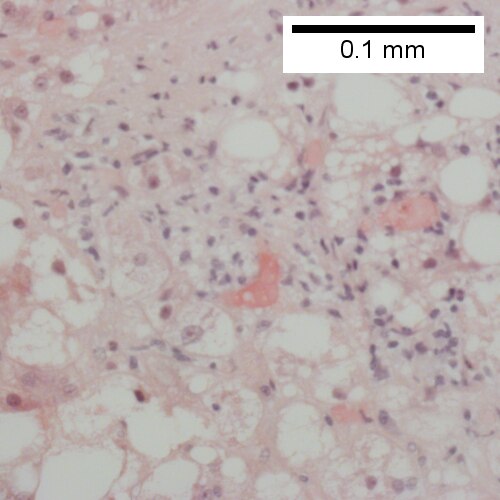
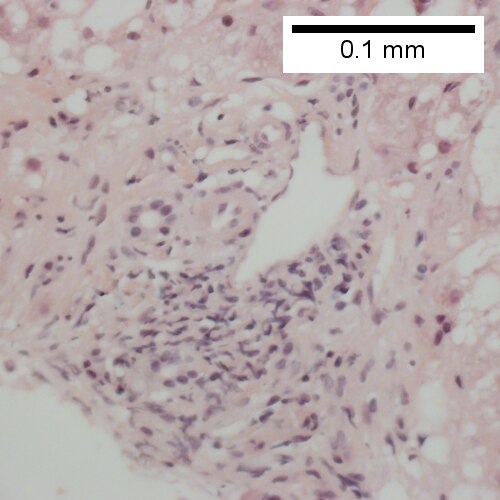
Steatohepatitis Brunt necroinflammatory grade 3, Brunt fibrosis stage 1 (not shown). Panacinar steatosis with unremarkable, small triads (UL 40X). Ballooning degeneration, with cytoplasmic tufts (arrows) (UR 400X). Lipogranuloma (LL 400X). Triad with mild chronic inflammation without interface hepatitis (LR 400X).
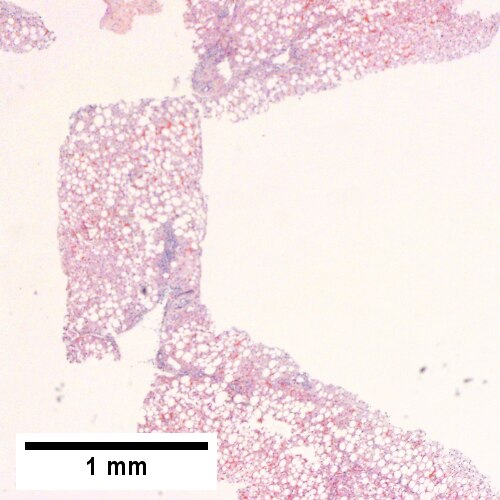
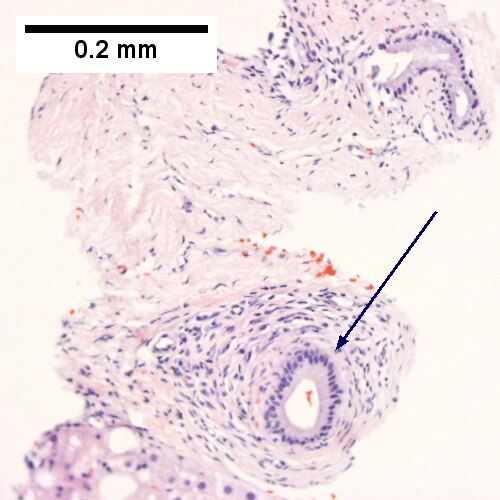
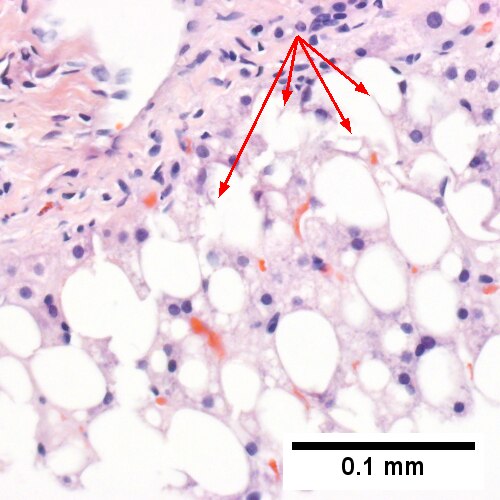
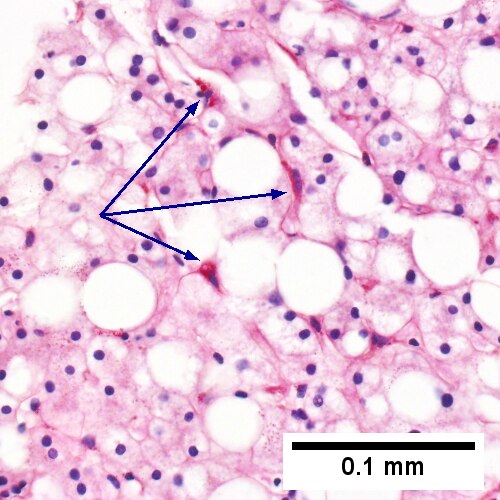
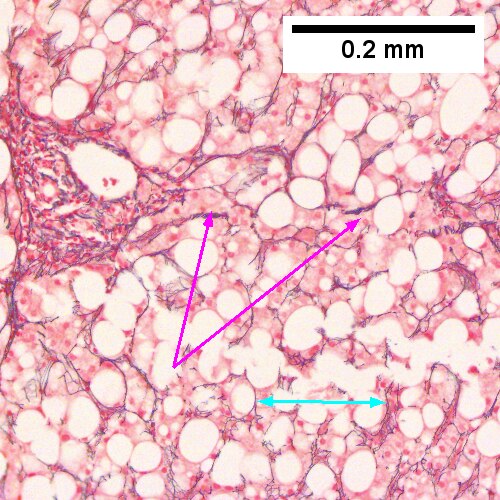
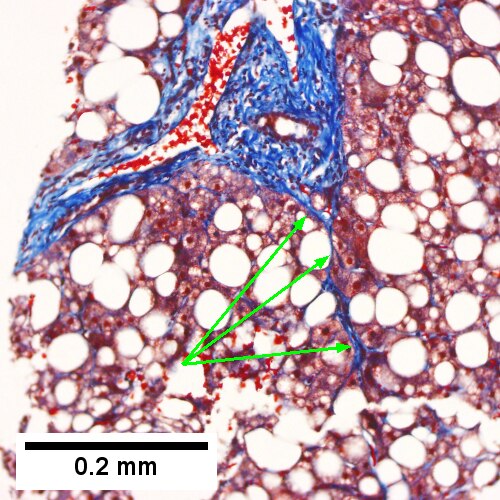
Steatohepatitis. Brunt necroinflammatory grade 3, Brunt fibrosis stage 3. Steatosis afflicts almost all hepatocytes (pan-acinar) (Row 1 Left 40X). An isolated septal duct with concentric fibrosis (arrow) should not result in a diagnosis of primary sclerosing cholangitis. The patient had a normal bilirubin. (Row 1 Right 200X). Cytoplasmic tufts (arrows) prove ballooning degeneration (Row 2 Left 400X). PAS with diastase shows PAS-D Kupffer cells (arrows) (Row 2 Right 400X). Reticulin shows thick black lines (red arrows) of collapse, without portal central bridging. The apparent loss of reticulin due to steatosis (double head cyan arrow) should not be considered regeneration or hepatoma (Row 3 Left 200X). Trichrome shows a bridge (arrows) (Row 3 Right 200X).
| Necroinflammatory grades Brunt 1, NAH 3. Fibrosis stage 0. About 25% of the liver shows steatosis (UL), not pan-acinar. Only rarely identified were either ballooned hepatocytes or inflammatory aggregates. UR shows more macrovesicular (blue arrowhead) than microvesicular (yellow arrowhead) steatosis, with occasional neutrophils in acini ( tip of green arrowhead, benath inflammatory aggregate, with tuft of material in ballooned hepatocyte at base of green arrow), and many glycogenated nuclei (magenta arrowhead). Additional evidence of hepatocellular damage is seen on the reticulin with focal zone III collapse (LL, blue arrowhead) and on the PAS with diastase stain with PAS-D Kupffer cells (LR black arrowheads)
Original oculars. UL 4X. UR 40X, LL 40X, LR 40X | |
| Necroinflammatory grades Brunt 2, NAH 6. Fibrosis stage 1. About half the hepatocytes show macrovesicular steatosis (UL), with sparing of part of the acinus (UL, Black arrowhead), Lipogranulomas, acomar inflammatory collections, mostly macrophages, about steatosis/ballooning degeneration afflicted hepatocytes or adjacent to them (UR, green arrowheads) are present.Tufts/flocks of ballooning degeneration are readily found (LL, magenta arrowheads). Mild to moderate mononuclear inflammation of portal triads does not exclude steatohepatitis (LL, yellow arrowheads). Trichrome displays the blue thin lines that separate hepatocytes in stage 1 fibrosis (LR blue arrowheads). Original oculars UL 4X, UR 40X (higher pixel photograph), LL 40X , LR 10X | |
| Necroinflammatory grades Brunt 1, NAH 3. Fibrosis stage 2. Overall, about a third of the biopsy shows mostly macrovesicular steatosis (UL). Rare inflammatory aggregates and ballooned hepatocytes were seen, but occasional linear/ropy Mallory hyalin was seen (UR blue arrowhead). Although trichrome can highlight Mallory hyalin (LL red arrowhead), the remainder of the image shows other cytoplasmic collections will also stain blue/blue-grey. The trichrome stain also showed peri-portal fibrosis (LR, yellow arrowheads). Original oculars UL 4X, UR 40X (higher pixel photograph), LL 40X (higher pixel photograph), LR 20X | |
| Necroinflammatory grades Brunt 3, NAH 8. Fibrosis stage 4. Steatosis is pan-acinar (UL). Acinar inflammatory aggregates More than 4 inflammatory aggregates are seen in a 20X field (UR black arrowheads). Many cells show ballooning degeneration, with tufts/flocks of material cytoplasm (LL yellow arrowheads) Trichrome limns regenerative nodules (LR magenta arrowheads). Original oculars UL 4X, UR 20X, LL 40X (higher pixel photograph), LR 10X |
See also
References
- ↑ Schumacher, JD.; Guo, GL. (Nov 2015). "Mechanistic review of drug-induced steatohepatitis.". Toxicol Appl Pharmacol 289 (1): 40-7. doi:10.1016/j.taap.2015.08.022. PMID 26344000.
- ↑ Farrell, GC. (2002). "Drugs and steatohepatitis.". Semin Liver Dis 22 (2): 185-94. doi:10.1055/s-2002-30106. PMID 12016549.
- ↑ Gramlich, T.; Kleiner, DE.; McCullough, AJ.; Matteoni, CA.; Boparai, N.; Younossi, ZM. (Feb 2004). "Pathologic features associated with fibrosis in nonalcoholic fatty liver disease.". Hum Pathol 35 (2): 196-9. PMID 14991537.
- ↑ 4.0 4.1 Brunt, EM.; Janney, CG.; Di Bisceglie, AM.; Neuschwander-Tetri, BA.; Bacon, BR. (Sep 1999). "Nonalcoholic steatohepatitis: a proposal for grading and staging the histological lesions.". Am J Gastroenterol 94 (9): 2467-74. doi:10.1111/j.1572-0241.1999.01377.x. PMID 10484010.
- ↑ Brunt, EM. (2001). "Nonalcoholic steatohepatitis: definition and pathology.". Semin Liver Dis 21 (1): 3-16. PMID 11296695.
- ↑ Brunt, EM.; Tiniakos, DG. (Nov 2010). "Histopathology of nonalcoholic fatty liver disease.". World J Gastroenterol 16 (42): 5286-96. PMID 21072891.

